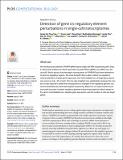| dc.contributor.author | Yeo, Grace Hui Ting | |
| dc.contributor.author | Juez, Oscar | |
| dc.contributor.author | Chen, Qing | |
| dc.contributor.author | Banerjee, Budhaditya | |
| dc.contributor.author | Chu, Lendy | |
| dc.contributor.author | Shen, Max Walt | |
| dc.contributor.author | Sabry, May | |
| dc.contributor.author | Logister, Ive | |
| dc.contributor.author | Sherwood, Richard I. | |
| dc.contributor.author | Gifford, David K | |
| dc.date.accessioned | 2021-04-23T19:12:59Z | |
| dc.date.available | 2021-04-23T19:12:59Z | |
| dc.date.issued | 2021-03 | |
| dc.date.submitted | 2020-08 | |
| dc.identifier.issn | 1553-7358 | |
| dc.identifier.uri | https://hdl.handle.net/1721.1/130516 | |
| dc.description.abstract | We introduce poly-adenine CRISPR gRNA-based single-cell RNA-sequencing (pAC-Seq), a method that enables the direct observation of guide RNAs (gRNAs) in scRNA-seq. We use pAC-Seq to assess the phenotypic consequences of CRISPR/Cas9 based alterations of gene cis-regulatory regions. We show that pAC-Seq is able to detect cis-regulatory-induced alteration of target gene expression even when biallelic loss of target gene expression occurs in only ~5% of cells. This low rate of biallelic loss significantly increases the number of cells required to detect the consequences of changes to the regulatory genome, but can be ameliorated by transcript-targeted sequencing. Based on our experimental results we model the power to detect regulatory genome induced transcriptomic effects based on the rate of mono/biallelic loss, baseline gene expression, and the number of cells per target gRNA. | en_US |
| dc.language.iso | en | |
| dc.publisher | Public Library of Science (PLoS) | en_US |
| dc.relation.isversionof | http://dx.doi.org/10.1371/journal.pcbi.1008789 | en_US |
| dc.rights | Creative Commons Attribution 4.0 International license | en_US |
| dc.rights.uri | https://creativecommons.org/licenses/by/4.0/ | en_US |
| dc.source | PLoS | en_US |
| dc.title | Detection of gene cis-regulatory element perturbations in single-cell transcriptomes | en_US |
| dc.type | Article | en_US |
| dc.identifier.citation | Yeo, Grace Hui Ting et al. "Detection of gene cis-regulatory element perturbations in single-cell transcriptomes." PLoS Computational Biology 17, 3 (March 2021): e1008789. © 2021 Yeo et al. | en_US |
| dc.contributor.department | Massachusetts Institute of Technology. Computer Science and Artificial Intelligence Laboratory | en_US |
| dc.contributor.department | Massachusetts Institute of Technology. Computational and Systems Biology Program | en_US |
| dc.relation.journal | PLoS Computational Biology | en_US |
| dc.eprint.version | Final published version | en_US |
| dc.type.uri | http://purl.org/eprint/type/JournalArticle | en_US |
| eprint.status | http://purl.org/eprint/status/PeerReviewed | en_US |
| dc.date.updated | 2021-04-22T12:08:54Z | |
| dspace.orderedauthors | Yeo, GHT; Juez, O; Chen, Q; Banerjee, B; Chu, L; Shen, MW; Sabry, M; Logister, I; Sherwood, RI; Gifford, DK | en_US |
| dspace.date.submission | 2021-04-22T12:08:57Z | |
| mit.journal.volume | 17 | en_US |
| mit.journal.issue | 3 | en_US |
| mit.license | PUBLISHER_CC | |
| mit.metadata.status | Complete | |
